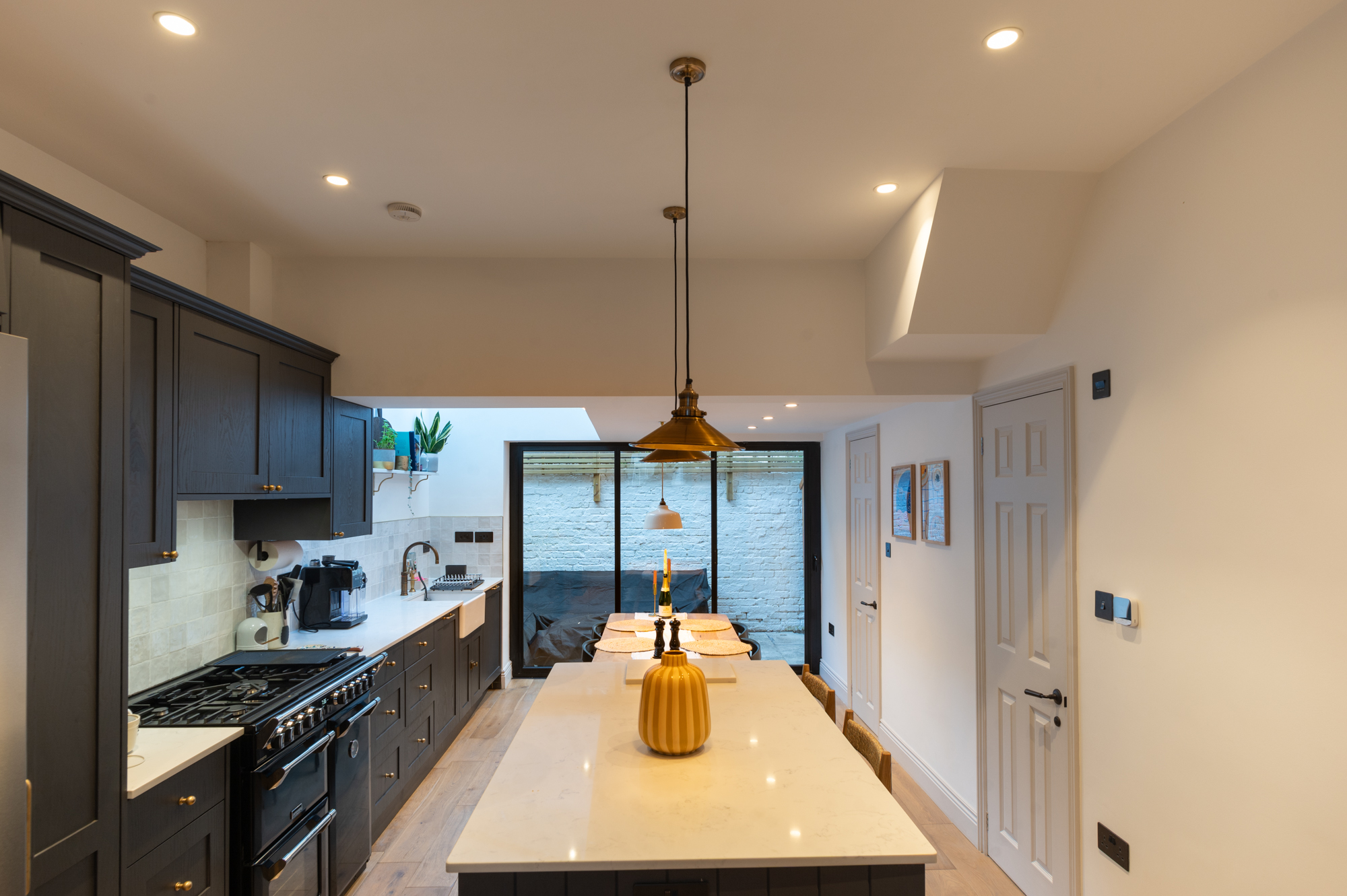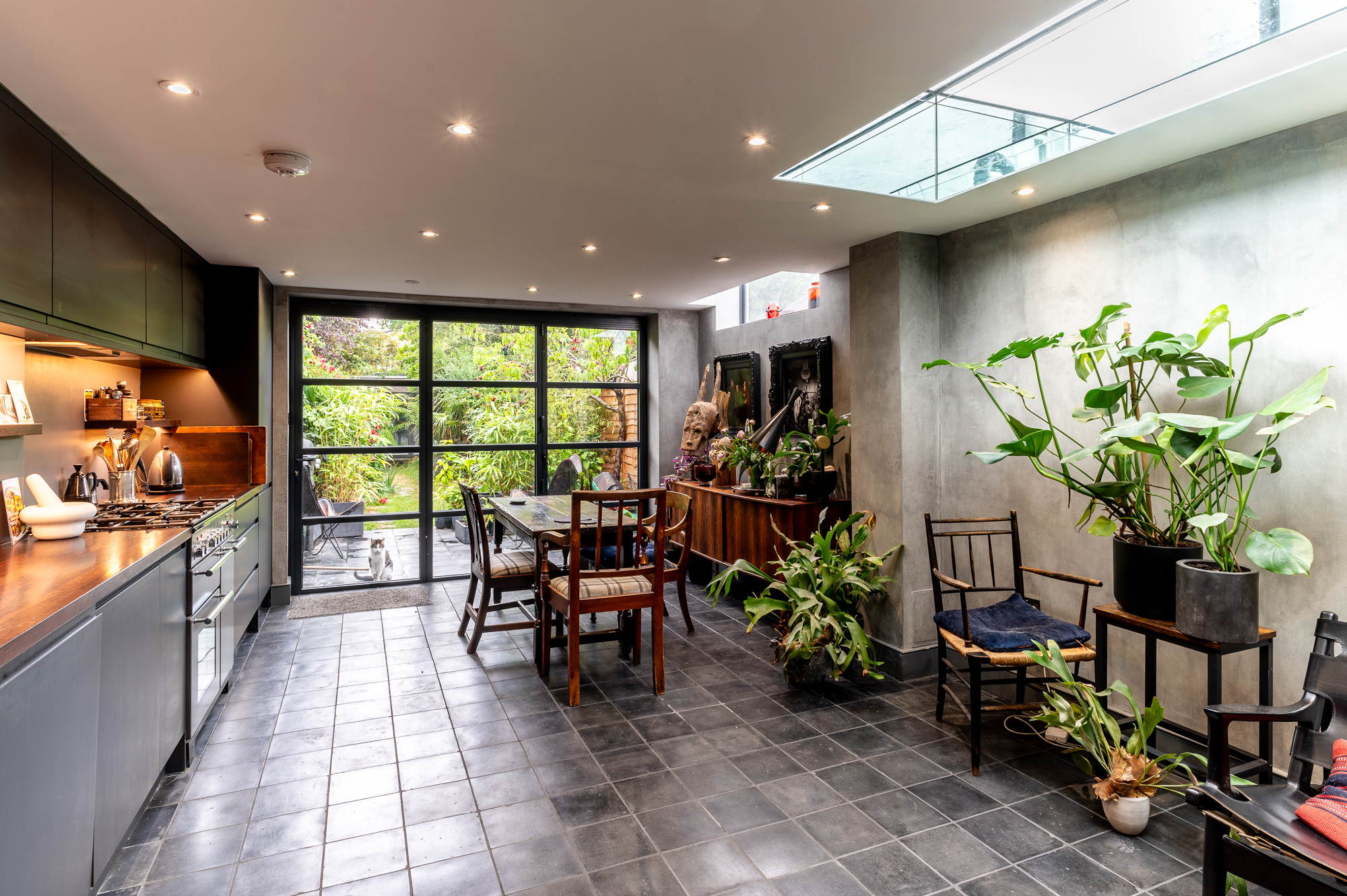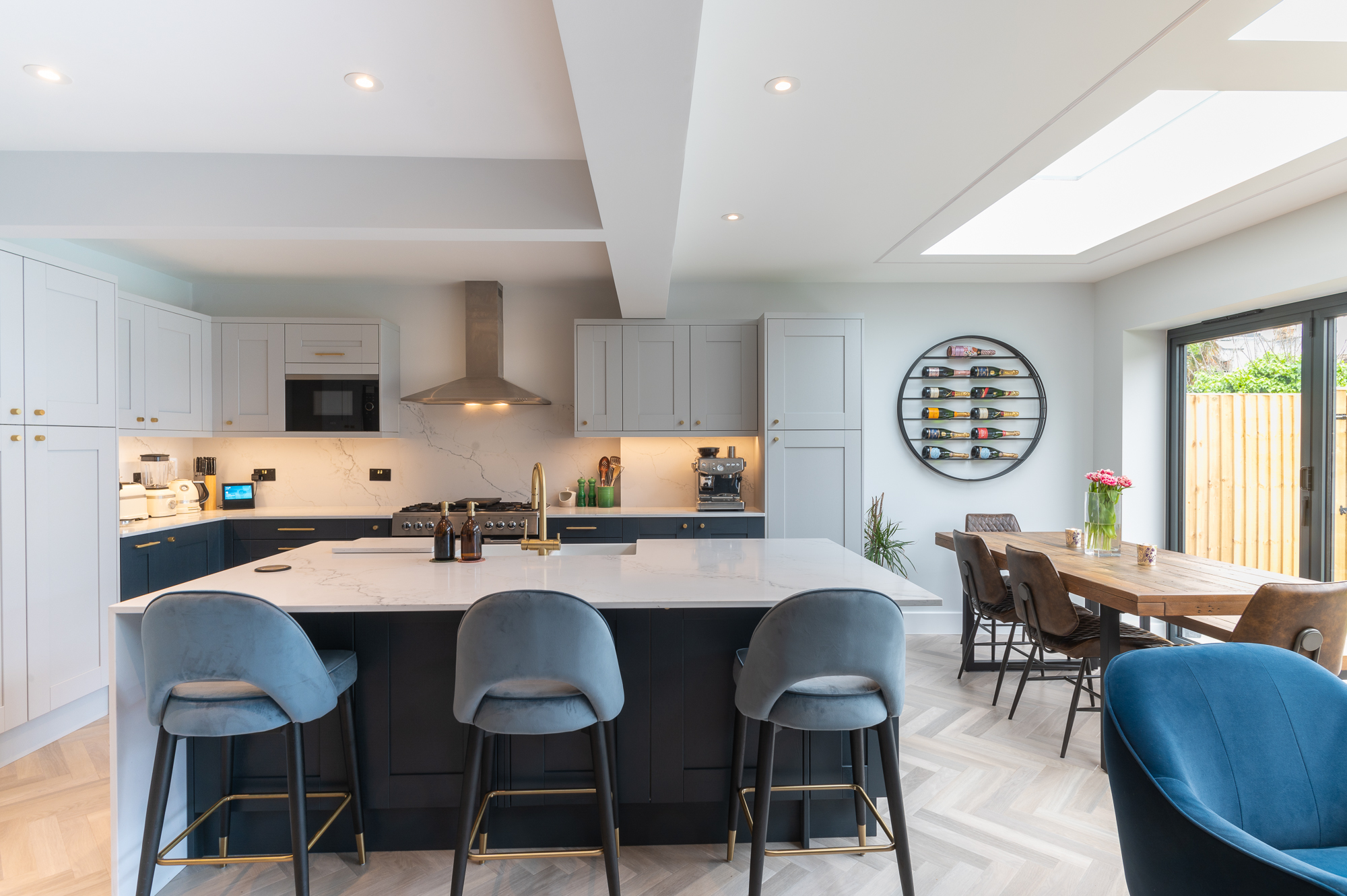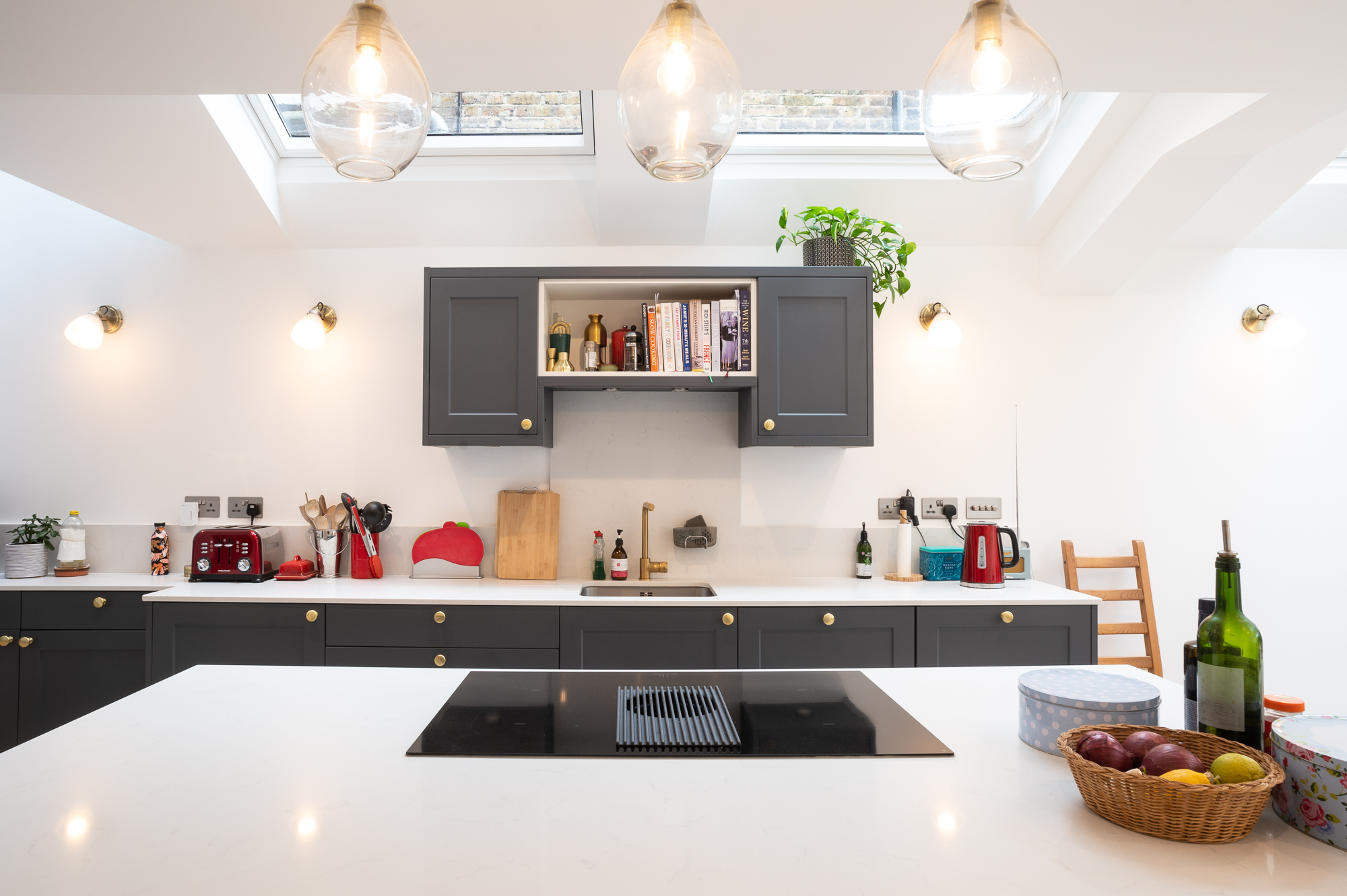One of the best-value locations in prime Zone 2, Lewisham, is an exciting regeneration area less than 6 miles from central London. Trains to London Bridge take only 12 minutes. All primary schools have a “good” or higher rating, with three secondary schools rated “outstanding” and majority rated ‘good’ by Ofsted. It also has lively street markets and green spaces. The staying power of Lewisham is strong, with homeowners trading up or building into the loft when they need more space. Loft conversions in Lewisham by Good Design & Build deliver creative bespoke solutions. Centred on value-adding designs drawn up by in-house architects, our projects feature quality craftsmanship and handpicked materials.
A loft conversion creates extra space by transforming an empty attic space of a house into a functional living area. It can create additional rooms within the existing footprint, like bedrooms, bathrooms, home offices, playrooms, art studios, or podcast rooms. Structural changes like reinforcing the floor, installing load-bearing beams, modifying roof trusses, insulating, plumbing, wiring, installing windows, and adding staircases are involved. Usually, Victorian and other period homes benefit from loft conversions due to the insulation of generous uninsulated loft spaces that contribute to heat loss through the roof.
Velux Loft Conversions – also called a Rooflight conversion, it’s suitable for lofts with sufficient head height. These do not involve any structural alterations to the roof. Installing roof windows, commonly high-efficiency Velux windows, brings in natural light and ventilation, turning the loft into a viable living space. The design is relatively straightforward, cost-effective, and less disruptive.
Dormer Loft Conversions – the existing roof gets extended vertically to increase head height in the loft area. They usually have a box shape, but pitched roofs can add intricacy. Dormers add more livable space compared to Rooflight conversions. These facilitate the addition of dormer windows for better functionality.
Hip-to-Gable Loft Conversions – used to improve headroom and floorspace in hipped roof lofts, they replace a hip end with a gable wall that reaches the height of the roof ridge. Hipped roofs contract the usable floor space due to hindered head height, and this method frees up plenty of functional space. 1930s semi-detached and end-of-terrace homes commonly benefit from this design.
L-shaped Loft Conversions – often added to Victorian terraced or semi-detached houses, they combine two dormers to create an L-shape. Usually, one dormer sits on the rear outrigger while the other is on the main roof. The design can easily accommodate a bedroom with an en suite. You can build a half rear dormer to add more space for a terrace and balcony.
Mansard Loft Conversions – creating substantial space for a large open-plan area or multiple rooms, they have the distinctive French Baroque style. They require extensive alteration to the roof structure. The existing roof gets replaced with a 72° wall and a steeper roof that has a nearly horizontal top. The top is flat or gently sloping. Mansards can be single or double.
Loft conversion costs usually depend on the style, size, and material. The type of roof and property type determine the type of loft conversion to utilise. We offer free consultation and itemised quotes to help you decide on the most suitable option. Basic costs are as follows;
Room in the roof conversion (basic) – £35,000
Dormer loft extension – £50,000
Mansard extension – £60,000 – £65,000
Hip-to-gable extension – £65,000
L-shaped extension – £65,000 – £75,000
Converting your loft is a great way to generate extra space without expanding the footprint of the building. However, its value and functionality depend on a polished outcome. DIY projects can diminish property values and, if unlawful, face demolition. Professionally executed loft conversions have the desired effects.
A team consisting of qualified architects, structural engineers, project managers, and builders brings expertise, efficiency, and experience to your project. They have a detailed understanding of planning permission requirements, building regulations, and other necessities. You will save time, money, effort, and disappointment when you have multi-disciplinary expertise working on your loft conversion in Lewisham.
We are Victorian and 1930s home remodellers specialising in design-based loft conversions. Our resident architects craft innovative solutions with bespoke plans that reflect your needs, your home’s existing architecture, and modern comfort. We create 3D renderings for better reimagining of spaces. Seamlessly integrated into your home, these contemporary spaces optimise natural light, versatility and enhanced aesthetics.
We offer you flexibility with two contracts for the design and build stages. Our planning team handles all pre-build logistics, including planning permission, applications for building control, Party Wall Agreements and method statements. A dedicated project manager oversees the construction process to ensure quality control and efficiency. Our finished products carry warranties.
The type of loft conversion, its size, and design features generally determine the cost. More straightforward designs tend to be less expensive. Choosing the conversion style depends on the type of roof, property type, and available space. Ensuring your loft conversion is both functionally and aesthetically appealing will give you a higher return on investment.
We offer end-to-end loft conversion solutions from conception to completion. Our services include a detailed design phase with architect-drawn plans, structural calculations, submitting planning applications, building control applications, preparing method statements, coordinating with planning authorities, project management, working with third-party suppliers, and issuing warranties for finished products.
Loft conversions do not always need planning permission as they are permitted developments. However, there are exceptions, such as living in a conservation area or a listed building, certain loft conversion styles, and when plans exceed PD limitations.
How we deliver projects
Our process is simple and divided into two distinct phases with separate contracts: Design and Build. As a client you only commit to one phase at a time depending on what stage of the process you are in. Each phase consists of three stages as described below.
1. Design
This is the kick-off point for your project. We carry out a complete architectural measured survey of the property. This allows us to create accurate CAD design drawings. This is followed by a design meeting to start discussing your ideas in more detail.
2. Planning
At this stage we finalise the designs with you and start preparing planning applications as needed. We place a high priority on ensuring that plans, designs and schedules are all based on a thorough and detailed understanding of planning guidelines. We co-ordinate with local authorities until the decision is made, and the planning approval is secured.
3. Technical
Once the planning consent is secured, we translate the design drawings into more detailed technical drawings for the purposes of building control and construction. This also includes specifications and structural calculations. At this stage, we will also submit to you our ‘no obligation’ quote for the build phase.
4. Pre-build
90% of our clients decide to stick with us after the design phase is completed. Once the build contract is signed, we kick off the process by making sure all the pre-build processes are complete. These include assistance with party wall agreements, Thames Water build over agreement, submitting building control application, and preparing method statements etc as needed. This stage ends with a pre-start meeting with your foreman before the actual build begins.
5. Build
One of our foremen will be dedicated to your project and will be on-site to manage everyday works. Our project managers will be overseeing the works to make sure they are completed to high standards, within your budget and on time. Throughout the process we will keep you updated with the progress and coordinate the works with third parties such as kitchen or flooring suppliers. We will also advise and guide you to choose any suppliers if needed.
6. Handover
As the build draws to finish, we will help to iron out any ‘snags’ to make sure everything is completed to your satisfaction. We will put together all necessary certificates such as gas, electricity and building control completion along with warranties for glazing, boiler etc. At the final completion meeting, we will hand you these documents, together with the keys to your house. Needless to say, you can contact us any time after this, if you want us to look at something.
This is the kick-off point for your project. We carry out a complete architectural measured survey of the property. This allows us to create accurate CAD design drawings. This is followed by a design meeting to start discussing your ideas in more detail.
At this stage we finalise the designs with you and start preparing planning applications as needed. We place a high priority on ensuring that plans, designs and schedules are all based on a thorough and detailed understanding of planning guidelines. We co-ordinate with local authorities until the decision is made, and the planning approval is secured.
Once the planning consent is secured, we translate the design drawings into more detailed technical drawings for the purposes of building control and construction. This also includes specifications and structural calculations. At this stage, we will also submit to you our ‘no obligation’ quote for the build phase.
90% of our clients decide to stick with us after the design phase is completed. Once the build contract is signed, we kick off the process by making sure all the pre-build processes are complete. These include assistance with party wall agreements, Thames Water build over agreement, submitting building control application, and preparing method statements etc as needed. This stage ends with a pre-start meeting with your foreman before the actual build begins.
One of our foremen will be dedicated to your project and will be on-site to manage everyday works. Our project managers will be overseeing the works to make sure they are completed to high standards, within your budget and on time. Throughout the process we will keep you updated with the progress and coordinate the works with third parties such as kitchen or flooring suppliers. We will also advise and guide you to choose any suppliers if needed.
As the build draws to finish, we will help to iron out any ‘snags’ to make sure everything is completed to your satisfaction. We will put together all necessary certificates such as gas, electricity and building control completion along with warranties for glazing, boiler etc. At the final completion meeting, we will hand you these documents, together with the keys to your house. Needless to say, you can contact us any time after this, if you want us to look at something.
What Our Clients Say
Featured Projects

Fulham
Orbain Road SW6 7JZ
This project was completed in 2023 and the approximate budget was £101,000.
Learn more

Lambeth
Hetherington Road SW4
We completed this stunning project for our client Angus in Lambeth.
Learn more

Teddington
Station Road SW4 7PA
We completed this exciting project for our clients on Station Road, a quaint residential area in the heart of Teddington.
Learn more

Leyton
Windsor Road E10
We completed this kitchen extension on Windsor Road, a charming residential street nestled in the heart of Leyton.
Learn more

Clapham
Hydethorpe Road SW12 0JF
We did this kitchen extension project for our clients in Hydethorpe Road SW12.
Learn more

Fulham
Orbain Road SW6 7JZ
This project was completed in 2023 and the approximate budget was £101,000.
Learn more

Lambeth
Hetherington Road SW4
We completed this stunning project for our client Angus in Lambeth.
Learn more

Teddington
Station Road SW4 7PA
We completed this exciting project for our clients on Station Road, a quaint residential area in the heart of Teddington.
Learn more

Leyton
Windsor Road E10
We completed this kitchen extension on Windsor Road, a charming residential street nestled in the heart of Leyton.
Learn more

Clapham
Hydethorpe Road SW12 0JF
We did this kitchen extension project for our clients in Hydethorpe Road SW12.
Learn more
Build a Quote!
Let's get started with building your own bespoke quote for your dream extension. Tell us as much in detail as possible to get most accurate price.
Get StartedBuild a Quote!
Let's get started with building your own bespoke quote for your dream extension. Tell us as much in detail as possible to get most accurate price.
Get Started








